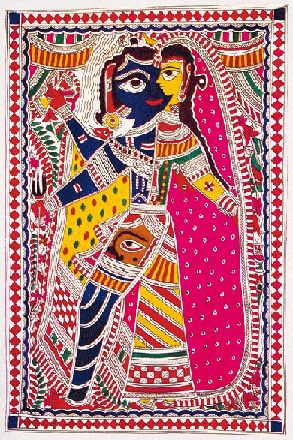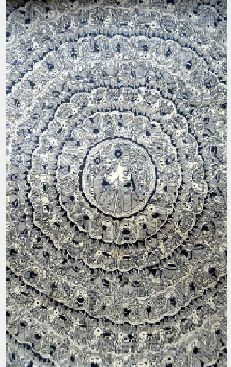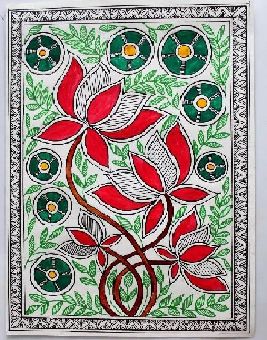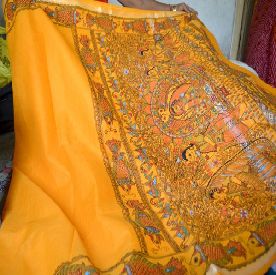Madhubani Paintings Easy
Sep 11, 2019 • 820 views
Originated in the small village of Mithila in Bihar and graciously practised in a number of regions in the aforementioned state as well as in Nepal, Madhubani art or Mithila art (after the city it started in) is one of the many beautiful and still popular folk arts of India. The history of this art form is tied to a very famous epic from ancient India, The Ramayana. According to the popular tales, Janaka Maharaj, the king of the kingdom of Mithila commissioned artists to decorate the premises with these paintings on the occasion of his daughter Sita's wedding to Lord Rama. This nearly 2500 years old art form has seen a lot of transitions, highs and lows and has not only survived over the years but has also adapted itself with the changing times.

Bharni Style Painting- Source : My Indian Culture
Designs and Styles
Tantrik, Kohbar, Bharni, Godhana and Kachni are the five types in which Madhubani paintings were originally categorized in.
Tantrik style solely focuses on religious texts and depicts different characters from them such as the manifestations of Maha Kali, Maha Durga and Maha Ganesha to name a few.
Bharni style as the name suggests means ‘filling’ and is one of the most famous styles of Madhubani art. This style uses vibrant colours like blue, yellow, orange etc to fill up the spaces with the subjects being outlined in black.
Kachni which literally means ‘lines’ is the style which makes use of fine lines to draw patterns with hatching and stippling. The artists in this style of painting work with few colours such as black and vermillion.
Godhana is the simplest style of Madhubani paintings and is commonly known as tattoo in the current times. This style focuses on geometric designs and uses parallel lines, concentric circles and rectangles to create different patterns.

Godhana Style Painting - Source : Dsource
Kohbar paintings are quite different than other forms of Madhubani art for instead of using black to outline it makes use of either just red or in combination with colours like yellow and blue. It is usually done on auspicious ceremonies like marriage. In the words of Punam Madhok - “Centuries of rituals have shaped the artistic vocabulary of these unusual wall paintings that represent love and fertility in marriage.” (Madhok, 2005)
Among these 5 styles, originally Tantrik, Bharni and Kohbar styles were done by women belonging to upper caste like Brahmin and Kayastha whereas the Kohbar and Godhana forms were used by people of the lower caste such as the Dalit community. But over the years the lines between these different forms and class distinctions of this art have blurred and given birth to the contemporary style of Madhubani paintings.
Popularization of the Art
Madhubani despite being an Indian art form born in a small village got its actual recognition by a foreigner. The seed of its popularization was sown during the 1934 Bihar earthquake, when William G.Archer while looking into the damage of the houses, discovered Madhubani art which was done on the walls of those dismantled houses. It was through his pictures and articles that these paintings were brought to public attention. These paintings were then encouraged by the All India Handicrafts Board to use them as a means of income during the drought of 1960. Slowly and steadily, the art form started to receive more attention, whether it was through Madhubani artists getting awards for their arts or the paintings being selected for presentation in various international events and exhibitions such as the International Folk Art Market in USA.
Cultural Significance
Madhubani paintings, from their start play a special role both in religious and social context. Their eminent connection with the religious tales is seen through their themes that revolve around Gods, Goddesses and various characters from mythological tales. These paintings have also been an essential part of the festivals and joyful ceremonies by acting as a medium of expression during these occasions. A lot of elements in these paintings are symbolic in nature and hold meanings and stories behind them. For example, fish signifies growth and prosperity, peacock acts as a symbol of love and devotion and continuation of human life is depicted through bamboo trees and lotus leaves. All these symbols are not just parts of the painting but in fact tell the stories of the culture and times that have passed.
Madhubani Art as a Tool for Empowerment
Art in many ways acts as a medium of liberation and empowerment and Madhubani is no different. Women had always been the main source behind the beautiful paintings that were and are still seen on the outside walls of the houses in many areas of Bihar. These women with the help of their skills in Madhubani art acted as a source of income during the 1960s drought in Bihar. Not just the All India Handicraft Boards but many other organisations have come forward to help the women establish themselves using Madhubani art, one such organization that is constantly working in this sector is the 'Shilp Sangh Co-operative society'. This art form is being used by many artists as a mode to create awareness about various social issues. These paintings are not just about details and aesthetics but they act as the voice of the people - Women, Dalits, the lower sections of the society and so many more.
Some Basic Techniques for Beginners, to Start with Madhubani Art
Before starting with any kind of creative activity, the first thing that we need are the materials that are to be used. Even though authentically Madhubani paintings are done on a wall or a particular kind of cloth with thin bamboo sticks as brushes and colours made with natural resources such as flowers, turmeric, sandalwood etc, contemporary times have brought in some changes. One can simply draw them on a handmade paper or a regular cloth with paint brushes and markers using poster or acrylic colours.
Moving further the first and foremost thing to do when starting with Madhubani is selecting a design. Despite the fact that Madhubani paintings are filled with intricate patterns, it is suggested for a beginner to choose from the simplest of Madhubani designs.

Easy Madhubani Design – Source: Creative Art Home
The next step would be to take a handmade paper or thick wide sheet and trace the pattern of the chosen design using a carbon paper. In order to begin with the painting, it is always better to start with the borders and then move towards the central character of the painting.
After this is done, one can start filling in the blank spaces that are left. Madhubani is all about detailing, hence it becomes important to use different patterns to fill up all the spaces. This might seem like a tedious task but the fact that there are no rules to the patterns that we draw, makes the task enjoyable.
When the detailing is done, it’s time to fill it up with colours. Depending on the styles one chooses, the colour choice changes. For example, Bharni is all about vibrancy whereas in Kachni style, the use of colours is minimum.
Some of the important characteristics of Madhubani paintings include the religious themes, portrayal of Hindu gods and goddesses and motifs inspired from nature such as the sun, moon, flowers, fishes, bamboo etc. The above-mentioned motifs are very important parts of Madhubani paintings, and they have symbolic meanings, thus one, with just a bit of creativity can infuse these to make their painting look better.
Madhubani Art in Contemporary Times and How to Do It
Over the years, Madhubani paintings have seen a lot of changes, from walls to paper and cloth, from the use of natural dyes to artificial colours etc. Despite all this, the essence of the art, the symbols and the themes are still the same. With the continuing worldwide popularization of the art, it is making its way in the lives of the people in many different forms. Madhubani nowadays is not just limited to walls or paper, but has expanded to various mediums. In the present time, one can see this art on clothes, stationary items, crockery designs, jars, mugs etc. With such liberty, anyone can bring Madhubani in their daily life by making simple designs on bookmarks, book covers, t-shirts etc.

Madhubani Design On Pen Holder - Source: Dsource

Madhubani Design On Cloth - Source: Dsource
Madhubani art has come a long way since its start and has a long way to go, preserving culture of a bygone era and carrying with itself bits and pieces of the present.
